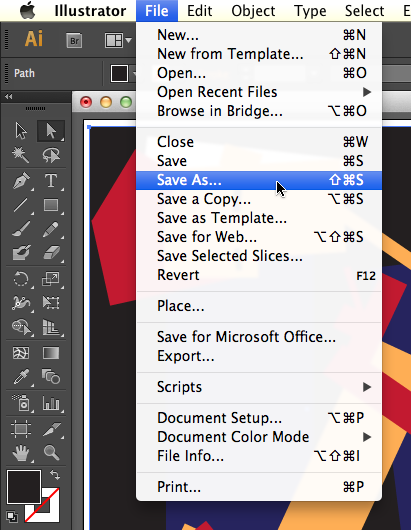1.4 Exercise 4: Saving a file
xtine burrough and Michael Mandiberg
Click File > Save As to open the Save dialog box. Choose a location in which to save your file. It is common to save files in the Documents folder. On a Mac, this is located in Macintosh HD/Users/Your_User_Name/Documents, and can be found on the left side of the Save dialog box. On Windows Vista, this is located at Start > My Documents. For this exercise name your file ch1-yourlastname-dynamiccomp.ai.

All actions that can be performed on your file are located in the File menu.
You must name your file when you save it. Follow these naming conventions:
- Avoid spaces. Instead, use_underscores_to_separate_words. Spaces are dangerous in web browsers. Any designer who plans to work with interactive media should form good habits by eliminating spaces from their file names.
- Use lowercase letters. This is also a convention of designers who name files that will be referenced in code. Spaces and uppercase letters will not damage your files, but if you are just beginning to form good habits, you might as well learn all of the rules at once.
- Never use characters such as those in the list below, as these reserved characters mean special things to applications and operating systems and can disable websites and crash applications.
The following are examples of reserved characters: ! @ # $ % ^ & * ( ) + = ~ [ ] ' " ? / \ , : ; > <
- Use a descriptive title, such as ch1-lastname-dynamiccomp.ai
[ex: ch1-keene-dynamiccomp.ai] - Including your full name in a file name is especially important if you are submitting a file in a classroom or professional setting.
- Make sure the file includes an extension. In this exercise, the file is saved as a an Illustrator® (.ai) document. The extension is .ai. In other words, the very worst file name that you could use is something like this: “My *best* ever/first file!” Not only does the name include spaces and reserved characters, it also fails to describe the file or format. Other bad names include the likes of “FINAL edit.ai,” “final.ai,” “composition.ai,” and other names that do not specify who made the file, or what is in the file. A better model for naming your files includes your individual or group name, a descriptive word about the contents of the file, and a date or versioning system. For example, when we sent a copy of our cover to the publisher on October 20th, we named it digitalfoundations_cover_1020.ai.
Native file format for master files
Most applications have a native file format for master files. This format can only be opened in the original program, and should be saved frequently throughout the working process. A copy of a master file is often created in a compressed, non-editable format when the author has finished editing the work. Compressing the file makes it smaller and easier to transfer. These compressed formats are readable by many applications, not just the original program. A .ai suffix indicates the file is an Illustrator® master file. If a logo, for example, was created in Adobe® Illustrator®, it could be shared with a friend or collaborator as a PDF file, which is viewable in Adobe® Acrobat® or Preview. These applications are installed on most computers. The exported files cannot be edited and are usually much smaller in file size. If the friend asks for revisions on the logo, the original AI file would be modified. After modification, a new PDF file would be saved and sent to the friend.
Closing and quitting
To close a file in Illustrator®, click the red button in the upper left corner of the window, click File > Close, or press Command+W. Quit the application by clicking Illustrator® > Quit or by using the keyboard shortcut Command+Q.
It is very important that file extensions, or suffixes, remain intact. The extension assists the computer operating system. It tells the system the type of file and the application to use when opening the file. This is especially important when bringing a file from one operating system to another (such as going from a Mac to a PC).
Some important file formats include:
.doc or .docx – Microsoft Word document
.rtf – Rich Text Format, non-proprietary word processing format
.txt – Text only, no formatting
.ai – Adobe® Illustrator® file
.pdf – Portable Document Format
.psd – Photoshop® document
.tif or .tiff – Tagged Image File – format for photographs, saved with lossless compression and used for scanning and printing. This format will be revisited in Chapter 7.
.jpg or .jpeg – Joint Photographic Experts Group – a compressed image file format often used for photographs on the web
.gif – Graphic Interchange Format – a compressed image file format often used on the web for logos, design elements, and other graphics with low numbers of colors.
.png – Portable Network Graphics (PNG /ˈpɪŋ/) is a raster graphics file format that supports lossless data compression. PNG was created as an improved, non-patented replacement for Graphics Interchange Format (GIF), and is the most used lossless image compression format on the Internet. [source: Wikipedia]
.html – HyperText Markup Language – a text file written in the language used to create web pages.
.fla – Flash® master file
.swf – Shock Wave Format – exported Flash® file for the web
Attribution
“Digital Foundations – Intro to Media Design” by Xtine Burroughs and Michael Mandiberg is licensed under CC BY-NC-SA 3.0 / This is a derivative from the original work. Content is available under Creative Commons Attribution Non-Commercial Share Alike unless otherwise noted.

